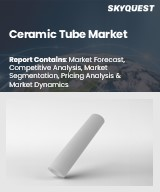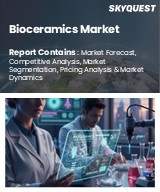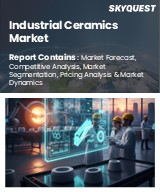
|
시장보고서
상품코드
1847149
세라믹관 시장 규모, 점유율, 성장 분석 : 유형별, 재료별, 용도별, 직경 범위별 - 산업 예측(2025-2032년)Ceramic Tube Market Size, Share, and Growth Analysis, By Type (Ceramic Insulators, Ceramic Capacitors), By Material (Alumina, Zirconia), By Application, By Diameter Range - Industry Forecast 2025-2032 |
||||||
세계의 세라믹관 시장 규모는 2023년에 211억 달러로 평가되었으며, 예측 기간(2025-2032년) 동안 CAGR은 5.8%로, 2024년 223억 2,000만 달러에서 2032년에는 350억 5,000만 달러로 성장할 전망입니다.
전 세계 세라믹관 시장은 특히 전자 산업의 급격한 성장과 지속가능한 인프라에 대한 투자 등 산업 전반에 걸친 고온 내성 소재에 대한 수요 증가로 인해 크게 성장하고 있습니다. 재료 과학과 에너지 효율의 기술 발전은 다양한 응용 분야에서 수요를 더욱 증가시키고 있습니다. 이 분야는 전기자동차 및 반도체 기술의 부상과 함께 발전, 야금, 화학 공정에서 내구성 소재의 필요성이 대두되면서 공급업체들의 관심이 높아지고 있습니다. 재생에너지로의 전환은 세라믹 부품의 사용을 촉진하고, 에너지 인프라에 대한 정부 투자는 수요를 증가시킬 것입니다. 그러나 제조 비용의 상승, 원자재 가격의 변동, 저렴한 대체품과의 경쟁 등의 문제는 더 넓은 시장 진입과 확장성을 저해하는 요인으로 작용할 수 있습니다.
세라믹관 세계 시장 촉진요인
세계 세라믹관 시장은 극한의 온도와 부식 환경에 견딜 수 있는 소재를 필요로 하는 발전, 야금, 화학 처리 등 다양한 산업 분야의 수요 증가로 인해 큰 성장을 거듭하고 있습니다. 뛰어난 열 안정성과 기계적 강도로 유명한 세라믹관은 이러한 까다로운 조건을 완벽하게 충족합니다. 산업계가 신뢰성과 내구성을 보장하는 고성능 소재를 우선시하는 가운데, 세라믹관의 채택이 증가하고 있으며, 이는 열악한 환경에서의 작업 효율과 수명을 향상시키는 첨단 소재의 채택이라는 광범위한 추세를 반영하고 있습니다.
세계 세라믹관 시장 억제요인
세라믹관의 제조 공정은 복잡하고 소결, 압출, 정밀 가공 등의 공정이 있으며, 특수 장비와 숙련된 인력이 필요합니다. 이러한 복잡성은 특히 고사양 애플리케이션의 경우 전체 제조 비용을 증가시켜 이러한 고급 세라믹관을 광범위한 잠재적 사용자가 이용하기 어렵게 만듭니다. 이러한 경제적 부담은 특히 중소규모의 제조업체들에게 큰 부담으로 작용하며, 경쟁력을 잃지 않으면서 이러한 비용을 관리하는 데 어려움을 겪는 경우가 많습니다. 결과적으로 높은 생산 비용은 세라믹관 시장의 성장과 혁신을 제한하고 다양한 산업 분야에서 확장 및 채택을 방해합니다.
세계 세라믹관 시장 동향
세계 세라믹관 시장에서 지속가능성으로의 전환이 두드러지게 나타나고 있으며, 바이오 기반 바인더, 재활용 가능한 세라믹 복합재 등 친환경 대안을 우선시하는 제조업체가 증가하고 있습니다. 이러한 추세는 탄소 없는 제조와 친환경 생산 방식을 중시하는 경향이 강화되고 있는 것이 배경입니다. 기업들은 첨단 세라믹 부품이 제공하는 본질적인 강도, 내열성, 내구성을 유지하면서 환경 발자국을 최소화하기 위해 폐쇄형 루프 제조 공정에 투자하고 있습니다. 산업계가 이러한 기술 혁신에 적응함에 따라 지속가능한 세라믹 솔루션에 대한 수요가 증가하여 시장의 미래를 형성하고 다양한 응용 분야에서 환경 친화적인 실천을 촉진할 것으로 예상됩니다.
자주 묻는 질문
목차
소개
- 조사 목적
- 조사 범위
- 정의
조사 방법
- 정보 조달
- 2차와 1차 데이터 방법
- 시장 규모 예측
- 시장 가정과 제한
주요 요약
- 세계 시장 전망
- 공급과 수요 동향 분석
- 부문별 기회 분석
시장 역학과 전망
- 시장 개요
- 시장 규모
- 시장 역학
- 성장 촉진요인과 기회
- 성장 억제요인과 과제
- Porters 분석
주요 시장 인사이트
- 핵심성공요인
- 경쟁 정도
- 주요 투자 기회
- 시장 생태계
- 시장 매력 지수(2024년)
- PESTEL 분석
- 거시경제 지표
- 밸류체인 분석
- 가격 분석
세라믹관 시장 규모 : 유형별 & CAGR(2025-2032년)
- 시장 개요
- 세라믹 절연체
- 세라믹 커패시터
- 세라믹 저항기
세라믹관 시장 규모 : 소재별 & CAGR(2025-2032년)
- 시장 개요
- 알루미나
- 지르코니아
- 질화붕소
세라믹관 시장 규모 : 용도별 & CAGR(2025-2032년)
- 시장 개요
- 일렉트로닉스
- 자동차
- 항공우주
세라믹관 시장 규모 : 직경 범위별 & CAGR(2025-2032년)
- 시장 개요
- 소구경(10 mm)
- 중구경(10-30 mm)
- 대구경(>30 mm)
세라믹관 시장 규모 & CAGR(2025-2032년)
- 북미
- 미국
- 캐나다
- 유럽
- 독일
- 스페인
- 프랑스
- 영국
- 이탈리아
- 기타 유럽
- 아시아태평양
- 중국
- 인도
- 일본
- 한국
- 기타 아시아태평양
- 라틴아메리카
- 브라질
- 기타 라틴아메리카
- 중동 및 아프리카
- GCC 국가
- 남아프리카공화국
- 기타 중동 및 아프리카
경쟁 정보
- 상위 5개사의 비교
- 주요 기업의 시장 포지셔닝(2024년)
- 주요 시장 기업이 채용한 전략
- 최근의 시장 동향
- 기업의 시장 점유율 분석(2024년)
- 주요 기업 개요
- 기업 상세
- 제품 포트폴리오 분석
- 기업 부문별 점유율 분석
- 매출 전년비 비교(2022-2024년)
주요 기업 개요
- Kyocera Corporation(Japan)
- CeramTec GmbH(Germany)
- Morgan Advanced Materials(U.K.)
- CoorsTek, Inc.(U.S.)
- Saint-Gobain(France)
- 3 M(U.S.)
- Vesuvius(U.K.)
- NGK Insulators, Ltd.(Japan)
- Heraeus Holding GmbH(Germany)
- Materion Corporation(U.S.)
- LSP Industrial Ceramics, Inc.(U.S.)
- Applied Ceramics(U.S.)
- Jyoti Ceramic Industries Pvt Ltd(India)
- Rauschert GmbH(Germany)
- Schunk Ingenieurkeramik GmbH(Germany)
- Carborundum Universal Ltd.(India)
- Ants Ceramics Private Limited(India)
- Technical Products, Inc.(U.S.)
- Insaco Inc.(U.S.)
- Valley Design Corp.(U.S.)
결론과 제안
KSM 25.10.28Global Ceramic Tube Market size was valued at USD 21.1 billion in 2023 and is poised to grow from USD 22.32 billion in 2024 to USD 35.05 billion by 2032, growing at a CAGR of 5.8% during the forecast period (2025-2032).
The global ceramic tube market is experiencing significant growth driven by heightened demand for high-temperature resistant materials across industrial sectors, particularly with the surge in the electronics industry and investments in sustainable infrastructure. Technological advancements in material science and energy efficiency are further propelling demand in various applications. The sector is witnessing increased momentum from suppliers due to the need for durable materials in power generation, metallurgy, and chemical processes, alongside the rise of electric vehicles and semiconductor technology. The shift to renewable energy sources bolsters the use of ceramic components, while government investments in energy infrastructure enhance demand. However, challenges such as high manufacturing costs and raw material price volatility, coupled with competition from cheaper alternatives, may hinder broader market access and scalability.
Top-down and bottom-up approaches were used to estimate and validate the size of the Global Ceramic Tube market and to estimate the size of various other dependent submarkets. The research methodology used to estimate the market size includes the following details: The key players in the market were identified through secondary research, and their market shares in the respective regions were determined through primary and secondary research. This entire procedure includes the study of the annual and financial reports of the top market players and extensive interviews for key insights from industry leaders such as CEOs, VPs, directors, and marketing executives. All percentage shares split, and breakdowns were determined using secondary sources and verified through Primary sources. All possible parameters that affect the markets covered in this research study have been accounted for, viewed in extensive detail, verified through primary research, and analyzed to get the final quantitative and qualitative data.
Global Ceramic Tube Market Segments Analysis
Global Ceramic Tube Market is segmented by Type, Material, Application, Diameter Range and region. Based on Type, the market is segmented into Ceramic Insulators, Ceramic Capacitors and Ceramic Resistors. Based on Material, the market is segmented into Alumina, Zirconia and Boron Nitride. Based on Application, the market is segmented into Electronics, Automotive and Aerospace. Based on Diameter Range, the market is segmented into Small Diameter (10 mm), Medium Diameter (10 - 30 mm) and Large Diameter (> 30 mm). Based on region, the market is segmented into North America, Europe, Asia Pacific, Latin America and Middle East & Africa.
Driver of the Global Ceramic Tube Market
The Global Ceramic Tube market is experiencing significant growth due to the rising demand from various industrial sectors such as power generation, metallurgy, and chemical processing, which require materials capable of withstanding extreme temperatures and corrosive environments. Ceramic tubes, known for their exceptional thermal stability and mechanical strength, perfectly meet the rigorous conditions of these applications. As industries continue to prioritize high-performance materials that ensure reliability and durability, the adoption of ceramic tubes is on the rise, reflecting a broader trend toward employing advanced materials that enhance operational efficiency and longevity in challenging settings.
Restraints in the Global Ceramic Tube Market
The manufacturing process of ceramic tubes is intricate, encompassing steps like sintering, extrusion, and precision machining, which require specialized equipment and highly skilled labor. This complexity adds to the overall production costs, especially for high-specification applications, making these advanced ceramic tubes less accessible to a broader range of potential users. This financial burden is particularly daunting for small- and medium-sized producers, who often struggle to manage these costs without sacrificing their competitive edge. Consequently, the high production expenses can limit the growth and innovation within the ceramic tube market, hindering its expansion and adoption in various industries.
Market Trends of the Global Ceramic Tube Market
The Global Ceramic Tube market is witnessing a notable shift towards sustainability, with manufacturers increasingly prioritizing environmentally friendly alternatives such as bio-based binders and recyclable ceramic composites. This trend is driven by a growing emphasis on carbon-free manufacturing and green production practices. Companies are investing in closed-loop manufacturing processes to minimize environmental footprints while maintaining the essential strength, heat resistance, and durability that advanced ceramic components offer. As industries adapt to these innovations, the demand for sustainable ceramic solutions is expected to rise, shaping the future of the market and fostering eco-conscious practices across various applications.
Table of Contents
Introduction
- Objectives of the Study
- Scope of the Report
- Definitions
Research Methodology
- Information Procurement
- Secondary & Primary Data Methods
- Market Size Estimation
- Market Assumptions & Limitations
Executive Summary
- Global Market Outlook
- Supply & Demand Trend Analysis
- Segmental Opportunity Analysis
Market Dynamics & Outlook
- Market Overview
- Market Size
- Market Dynamics
- Drivers & Opportunities
- Restraints & Challenges
- Porters Analysis
- Competitive rivalry
- Threat of substitute
- Bargaining power of buyers
- Threat of new entrants
- Bargaining power of suppliers
Key Market Insights
- Key Success Factors
- Degree of Competition
- Top Investment Pockets
- Market Ecosystem
- Market Attractiveness Index, 2024
- PESTEL Analysis
- Macro-Economic Indicators
- Value Chain Analysis
- Pricing Analysis
Global Ceramic Tube Market Size by Type & CAGR (2025-2032)
- Market Overview
- Ceramic Insulators
- Ceramic Capacitors
- Ceramic Resistors
Global Ceramic Tube Market Size by Material & CAGR (2025-2032)
- Market Overview
- Alumina
- Zirconia
- Boron Nitride
Global Ceramic Tube Market Size by Application & CAGR (2025-2032)
- Market Overview
- Electronics
- Automotive
- Aerospace
Global Ceramic Tube Market Size by Diameter Range & CAGR (2025-2032)
- Market Overview
- Small Diameter (10 mm)
- Medium Diameter (10 - 30 mm)
- Large Diameter (> 30 mm)
Global Ceramic Tube Market Size & CAGR (2025-2032)
- North America (Type, Material, Application, Diameter Range)
- US
- Canada
- Europe (Type, Material, Application, Diameter Range)
- Germany
- Spain
- France
- UK
- Italy
- Rest of Europe
- Asia Pacific (Type, Material, Application, Diameter Range)
- China
- India
- Japan
- South Korea
- Rest of Asia-Pacific
- Latin America (Type, Material, Application, Diameter Range)
- Brazil
- Rest of Latin America
- Middle East & Africa (Type, Material, Application, Diameter Range)
- GCC Countries
- South Africa
- Rest of Middle East & Africa
Competitive Intelligence
- Top 5 Player Comparison
- Market Positioning of Key Players, 2024
- Strategies Adopted by Key Market Players
- Recent Developments in the Market
- Company Market Share Analysis, 2024
- Company Profiles of All Key Players
- Company Details
- Product Portfolio Analysis
- Company's Segmental Share Analysis
- Revenue Y-O-Y Comparison (2022-2024)
Key Company Profiles
- Kyocera Corporation (Japan)
- Company Overview
- Business Segment Overview
- Financial Updates
- Key Developments
- CeramTec GmbH (Germany)
- Company Overview
- Business Segment Overview
- Financial Updates
- Key Developments
- Morgan Advanced Materials (U.K.)
- Company Overview
- Business Segment Overview
- Financial Updates
- Key Developments
- CoorsTek, Inc. (U.S.)
- Company Overview
- Business Segment Overview
- Financial Updates
- Key Developments
- Saint-Gobain (France)
- Company Overview
- Business Segment Overview
- Financial Updates
- Key Developments
- 3M (U.S.)
- Company Overview
- Business Segment Overview
- Financial Updates
- Key Developments
- Vesuvius (U.K.)
- Company Overview
- Business Segment Overview
- Financial Updates
- Key Developments
- NGK Insulators, Ltd. (Japan)
- Company Overview
- Business Segment Overview
- Financial Updates
- Key Developments
- Heraeus Holding GmbH (Germany)
- Company Overview
- Business Segment Overview
- Financial Updates
- Key Developments
- Materion Corporation (U.S.)
- Company Overview
- Business Segment Overview
- Financial Updates
- Key Developments
- LSP Industrial Ceramics, Inc. (U.S.)
- Company Overview
- Business Segment Overview
- Financial Updates
- Key Developments
- Applied Ceramics (U.S.)
- Company Overview
- Business Segment Overview
- Financial Updates
- Key Developments
- Jyoti Ceramic Industries Pvt Ltd (India)
- Company Overview
- Business Segment Overview
- Financial Updates
- Key Developments
- Rauschert GmbH (Germany)
- Company Overview
- Business Segment Overview
- Financial Updates
- Key Developments
- Schunk Ingenieurkeramik GmbH (Germany)
- Company Overview
- Business Segment Overview
- Financial Updates
- Key Developments
- Carborundum Universal Ltd. (India)
- Company Overview
- Business Segment Overview
- Financial Updates
- Key Developments
- Ants Ceramics Private Limited (India)
- Company Overview
- Business Segment Overview
- Financial Updates
- Key Developments
- Technical Products, Inc. (U.S.)
- Company Overview
- Business Segment Overview
- Financial Updates
- Key Developments
- Insaco Inc. (U.S.)
- Company Overview
- Business Segment Overview
- Financial Updates
- Key Developments
- Valley Design Corp. (U.S.)
- Company Overview
- Business Segment Overview
- Financial Updates
- Key Developments



















